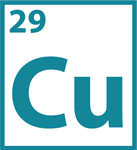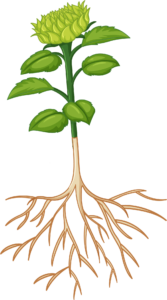Symbol: Cu
Availability: is taken up preferentially as Cu2+
Copper functions

It is necessary for chlorophyll formation, playing a vital role in photosynthesis efficiency.


It is activator of several enzymes and Essential for the mitochondrial respiration processes.

It plays an important role in the formation of lignin, an integral composite of cell walls.

It contributes to seed set, stress resistance, and pollen production.
Copper (Cu) is a redox-active transition element with roles in photosynthesis, respiration, C and N metabolism, and protection against oxidative stress. Like Fe, it forms highly stable complexes and participates in electron transfer reactions. more than 98% of the Cu in plants is present in complexed forms and the concentrations of free Cu2+ and Cu+ is extremely low in the cytoplasm. The concentration of copper within the plant varies on average between 5 and 20 ppm.
Concentration in soil ranges from 2 to 100 parts per million (ppm), with an average value of about 30 ppm. Most of the Cu in the soil is not available for plants. Copper exists in soil as Cu2+ and most of the copper is taken up by the plant in that form. Besides, copper is the most immobile micronutrient in soil.
Mobility within the plant is rather low as it slowly transfers from the roots to the aerial part and is poorly redistributed within the plant. Therefore, deficiency symptoms usually appear in young tissues.
In plants, copper can perform its function both as a free ion and complexed in highly stable molecules.
Copper is an essential element for plant growth, in fact, crops are unable to complete their biological cycle in the absence of this nutrient and function of copper cannot be replaced by another nutritional element.
Copper is directly involved in plant metabolism and it is necessary for chlorophyll formation, playing a vital role in photosynthesis efficiency. It is activator of several enzymes, including the catalysis of vitamin A production. It is essential for the mitochondrial respiration processes, for iron mobilization and phytohormone signaling. It also plays a role in the formation of lignin and contributes to seed set, stress resistance, and pollen production.
Copper deficiency generally manifests itself with yellowing and necrosis of the leaves, decay of branches and shoots, stunted growth. In the case of fruit trees, due to the lack of this element, the leaves wither and fall, while the bark becomes rough and fissures exuding gummy substances.
Given its many important functions, plants deficient in copper can show reduced photosynthetic activity, reduced synthesis of carbohydrates, reduced nodulation and nitrogen fixation (in leguminous plants), reduced or inhibited growth, reduced stress resistance, reduced efficiency in the transport and use of water and reduced production (seeds and fruits).
Availability of copper increases in soil pH below 7.0 and decreases at a higher pH, due to fixation to soil clay minerals. Copper can also be adsorbed to iron and manganese oxides and precipitate with carbonate and phosphate minerals. Limited availability of copper occurred also in peaty soils or in soils with high concentrations of organic matter.
Cu deficiency can occur in soils with high pH where higher amount of unavailable copper held by clay and organic matter. Besides, high intake of phosphorus and nitrogen can reduce copper availability due to the formation of insoluble copper phosphates or poorly assimilable organic copper complexes. Besides, also in the soil-less growing method all the nutrients essential to the plant, including copper, have to be applied via the drip irrigation system or as foliar spray. The best way to apply copper is through foliar spray to avoid insolubilization processes that can occur in the soil. Hello Nature’s R&D found a solution to protect the environment and at the same time bring copper to the plant in a safe and effective way. Copper complexed with organic molecules like gluconic acid can be easily assimilated by crops through the leaves. This penetrating form of copper exerts an excellet agronomic and environmental efficiency. The gluconic acid is a weak acid with high complexing capacity. It is naturally present in plants and in food, non-toxic and totally usable by living organisms. Gluconic acid improves copper assimilation and mobility into the plants.
Copper is an essential element for plant growth, in fact, crops are unable to complete their biological cycle in the absence of this nutrient and function of copper cannot be replaced by another nutritional element.







